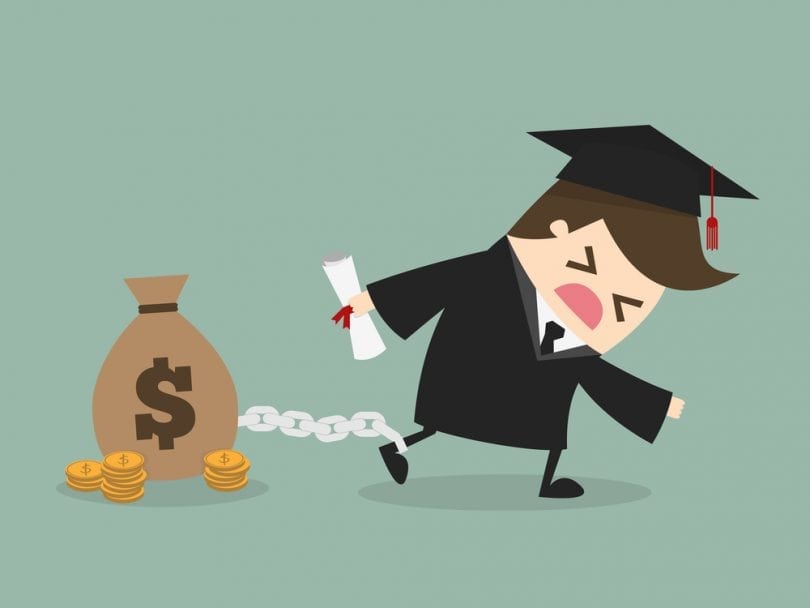In most ways, March 23, 2012 was like any other day. It was a Friday morning. I woke up around 6:00 am to an alarm. But as I was getting ready for work, I logged into my computer to check my account balances. It was a ritual every other Friday on payday. But this week something different happened.
I looked at my bank account balance and saw it had grown to exceed my remaining student loan balance! Two years and six days after graduation, I was ready to make my final student loan payment. I didn’t get there making only minimum payments. Instead, I used a focused approach to strategically eliminate my $40,000 student loans. Follow along to learn how it all came together.
Start paying while still in school
The first step I took to paying off my student loans was to start paying during school. Unlike most of my classmates, I kept a full-time job while going to school full-time for my MBA. A combination of an understanding boss and a complete focus on schoolwork on evenings and weekends made it a possibility.
My loans were all government back Stafford Loans. One-third of my loans were subsidized and did not incur any interest during school. Two-thirds were unsubsidized and began accruing interest right away. I focused my efforts on those loans while in school.
I didn’t make big payments and there was no minimum payment, so I just made sure to pay at least the interest, if not a little more, every month. I kept this up until my last quarter (my university ran on the quarter system) when I made my last tuition payment and took on my final loans. At that point, I started making more aggressive payments.
Pay more than the minimum
When I graduated in March 2010, I went into full payoff mode. I lived in a low-cost house with a roommate for most of my MBA program to keep costs down, and eventually moved into a small one-bedroom apartment far from downtown to keep my rent low.
Keeping all of my expenses low and living on a college style budget while working a full-time job as a Financial Analyst allowed me to pay a lot more than the minimum payment each month. I also split my payment into a smaller payment every payday instead of monthly to keep my income in-line with my expenses.
I started paying half of my loan payment automatically every payday and slowly increased it. I eventually surpassed the full payment amount twice each month and did everything I could to increase that payment.
That meant I didn’t spend as much as friends on cars, housing, eating out at restaurants, and buying fancy gadgets. I didn’t buy a smartphone until most of my friends already had one to save money.
In addition to making payments a little easier, paying every other week instead of monthly gives you a full extra monthly payment each year in many cases. If you get 26 paychecks per year and pay automatically on payday, you’ll get this added 13th month payment!
I even cancelled my cable in 2011 to save the $70 per month I was paying Comcast to watch TV. Cutting cable both boosted my side hustle income (I spent time hustling instead of watching TV) and gave me extra money for my loans. Don’t discount the power of earning more to pay off your loans faster in addition to cutting costs. I never got cable again and I’ve saved about $6,000 on TV since!
Every lump sum goes to loans
The final slice of the pie came from lump and one-time income. I worked hard to get a job that gave me an annual bonus, and while it wasn’t huge I put every dollar of it into my student loans. The same was true for my annual tax refund, which gave me a couple thousand dollars more to dump into the loans.
Because you are used to living without the money anyway, don’t be tempted to spend one-time income on a vacation or a new Gucci accessory. Instead, funnel those dollars into your loan for a faster payoff.
This is why living on a budget is so important. If you don’t budget, you could find yourself in credit card debt or living paycheck-to-paycheck. In those scenarios, it is far more tempting to use lump income to pay for regular living expenses. You might even need it for high-interest credit card debt instead of your student loans. Budgeting is not optional if you want to pay off your student loans early.
A side benefit: my credit went up!
Paying off my loans early helped me free up cash flow for the future and gave me more freedom with how to use my newly disposable income. The main reason I wanted to pay off my loans early, however, was to save money on interest.
Interest charges compound based on the balance at the end of the month, so paying my loans early meant I also paid less interest. But while that was a great benefit of an early payoff, I still enjoy a higher credit score thanks to my early payoff.
My credit score was around 700 when I started tracking it around ten years ago. I’m now a proud member of the 800+ club thanks to my early student loan payoff!
Prepare for payoff day
Back to March 23, 2012. That morning, I made a single payment for $3,690.52 to close out my student loans for good. It felt great!
Screenshot showing my final loan payment amount. $3,690.52. Taken just a few days before paying off my loans for good!
That morning, I headed out into an unseasonably warm Denver day for work knowing I would never have to make another student loan payment again. I started saving that big monthly payment for a home down payment and my first year contributing the maximum to my Roth IRA. I turned that debt snowball into a savings snowball, and the momentum never stopped.
I didn’t use any special magic tricks. I just kept expenses low, put every dollar possible into my loans, and kept on going until the balance said zero. If you follow a similar approach to your loan payoff, it’ll be paid off before you know it!




